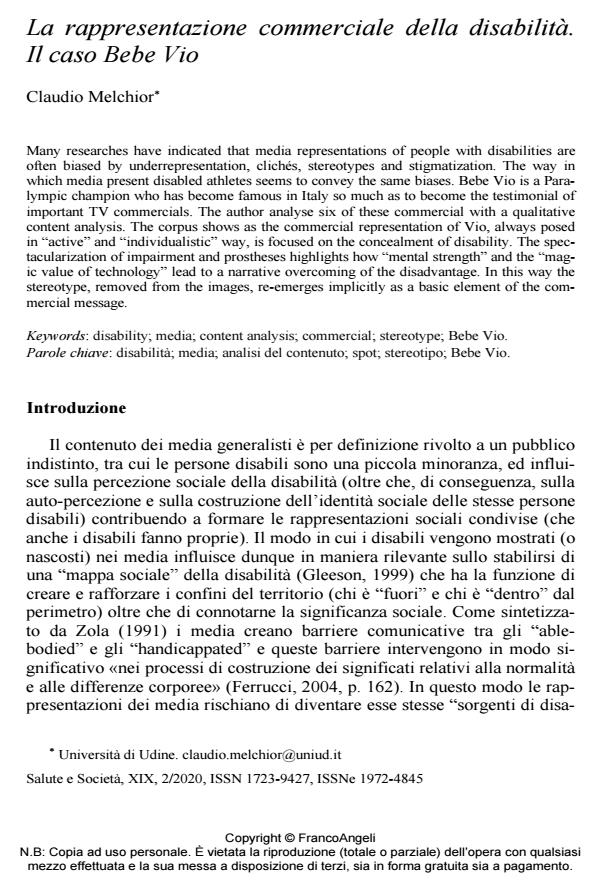La rappresentazione commerciale della disabilità. Il caso Bebe Vio
Titolo Rivista SALUTE E SOCIETÀ
Autori/Curatori Claudio Melchior
Anno di pubblicazione 2020 Fascicolo 2020/2 Lingua Italiano
Numero pagine 15 P. 121-135 Dimensione file 170 KB
DOI 10.3280/SES2020-002009
Il DOI è il codice a barre della proprietà intellettuale: per saperne di più
clicca qui
Qui sotto puoi vedere in anteprima la prima pagina di questo articolo.
Se questo articolo ti interessa, lo puoi acquistare (e scaricare in formato pdf) seguendo le facili indicazioni per acquistare il download credit. Acquista Download Credits per scaricare questo Articolo in formato PDF

FrancoAngeli è membro della Publishers International Linking Association, Inc (PILA)associazione indipendente e non profit per facilitare (attraverso i servizi tecnologici implementati da CrossRef.org) l’accesso degli studiosi ai contenuti digitali nelle pubblicazioni professionali e scientifiche
;
Keywords:Disabilità; media; analisi del contenuto; spot; stereotipo; Bebe Vio.
- Amaturo E. (1993). Messaggio, simbolo, comunicazione. Roma: Carocci.
- Barnes C., Mercer G., Shakespeare T. (1999). Exploring Disability: A SociologicalIntroduction. Cambridge: Polity Press.
- Barnartt S. (2001). Using role theory to describe disability. Research in Social Science and Disability, Vol. 2. DOI: 10.1016/S1479-3547(01)80020-
- Barton L. (1993). Disability, empowerment and physical education. In: Evans J., a cura di, Equality, education and physical education, 43-54. London: The Falmer Press.
- Beacom A., Brittain, I. (2016). Public diplomacy and the international Paralympic committee: Reconciling the roles of disability advocate and sports regulator. Diplomacy & Statecraft, 27(2): 273–294. DOI: 10.1080/09592296.2016.116979
- Besio S., Roncarolo F., a cura di (1996). L’handicap dei media. Disabili e disabilità nell’offerta televisiva. Roma: Rai Libri.
- Brittain I. (2017). Communicating and Managing the Message: Media and Media Representation of Disability and Paralympic Sport. In: Darcy S., Frawley S., Adair D., a cura di, Managing the Paralympics. London: Palgrave Macmillan.
- Carlson L. (2009). The Faces of Intellectual Disability. Philosophical Reflections. Indiana: Indiana University Press.
- Carlson L. (2001). Cognitive Ableism and Disability Studies: Feminist Reflections on the History of Mental Retardation. Hypatia, Vol. 16, No. 4: 124-146.
- Censis (2004). Media e disabili. L’immagine della disabilità in tv. Note & Commenti, 3.
- Cesareo V, Vaccarini I. (2012). L’era del narcisismo. Milano: FrancoAngeli.
- Chang I.Y., Crossman J. (2009). “When there is a will, there is a way”: A quantitative comparison of the newspaper coverage of the 2004 Summer Paralympic and Olympic Games. International Journal of Applied Sports Sciences, 21(2): 16–34.
- Clogston J.S. (1990). Disability coverage in 16 newspapers. Louisville: Avocado Press.
- Darke P.A. (2004). The changing face of representations of disability in the media. In: Thomas C., Swain J., Barnes C., French S., a cura di, Disabling barriers, enabling environments. London: Sage Publications.
- Davis, L.J. (1995). Enforcing Normalcy: Disability, Deafness, and the Body. London: Verso.
- Di Santo R. (2013). Sociologia della disabilità. Teorie, modelli, attori e istituzioni. Milano: Franco Angeli.
- Ferrucci F. (2004). La disabilità come relazione sociale. Gli approcci sociologici tra natura e cultura. Catanzaro: Rubettino.
- Fraser B. (2013). Disability Studies and Spanish Culture: Films, Novels, the Comic and the Public Exhibition. Liverpool: Liverpool University Press.
- Gadotti G. (2003). Pubblicità sociale. Lineamenti, esperienze e nuovi sviluppi. Milano: Franco Angeli.
- Gilbert K., Schantz O.J. (2012). An implosion of discontent. In: Schantz O.J., Gilbert K., a cura di, Heroes or zeroes? The media’s perceptions of Paralympic Sport. Champaign: Common Ground Publishing.
- Gleeson B.J. (1999). Geographies of Disability. London: Routledge.
- Goffman E. (1963). Stigma: Notes on the management of spoiled identity. Englewood Cliffs: Prentice-Hall.
- Goggin G., Hutchins B. (2017). Media and the Paralympics: Progress, Visibility, and Paradox. In: Darcy S., Frawley S., Adair D., a cura di, Managing the Paralympics. London: Palgrave Macmillan.
- Haller B.A. (1995). Rethinking Models of Media Representation of Disability. Disability Studies Quarterly, 15, 2: 26-30.
- Haller B., Ralph S. (2001). Content analysis methodology for studying news and disability: Case studies from the United States and England. In: Barnartt S., Altman B., a cura di, Exploring Theories and Expanding Methodologies: Where we are and where we need to go. Bingley: JAI Press.
- Hardin B., Hardin M. (2003). Conformity and conflict. Wheelchair athletes discuss sport media. Adapted Physical Activity Quarterly, 20, 3: 246-259.
- Jones C. (2012). Literature Review: Journalism and Disability from a Canadian Perspective. Canadian Journal of Disability Studies.
- Katz E., Blumler J.G., Gurevitch M. (1973). Uses and Gratifications Research. Public Opinion Quarterly, 37, 4: 509–523. DOI: 10.1086/26810
- Keller C.E., Hallahan D.P., McShane E.A., Crowley E.P., Blandford B.J. (1990).
- The Coverage of Persons with Disabilities in American Newspapers. The Journal of Special Education, 24, 3: 271–282. DOI: 10.1177/00224669900240030
- Lane H. (1993). The Mask of Benevolence: Disabling the Deaf Community. New York: Vintage.
- Liachowitz C.H. (1988). Disability as a Social Construct: Legislative Roots. Philadelphia: University of Pennsylvania Press.
- Pappous, A., (2008), The photographic coverage of the Paralympic Games. Paper presentato al Third Annual International Forum on Children with Special Needs “Sport and Ability”, Shafallah Centre, Doha, Qatar, 20–22 April.
- Purdue D.E.J., Howe P.D. (2012). See the sport, not the disability: Exploring the Paralympic paradox. Qualitative Research in Sport, Exercise and Health, 4(2): 189–205. DOI: 10.1080/2159676X.2012.68510
- Reiser R., Mason M. (1990). Disability equality in the classroom: A human rights issue. London: Inner London Education Authority.
- Williams-Findlay R. (2014). The representation of disabled people in the news media. In: Swain J., French S., Barnes C., Thomas C., a cura di, Disabling barriers, enabling environments. London: Sage Publications.
- Zola I.K. (1991). Communication barriers between “the able-bodied” and “the handicapped”. In: Marini I. e Stebnicki M.A., a cura di, The Psychological and Social Impact of Illness and Disability. New York: Springer.
Claudio Melchior, La rappresentazione commerciale della disabilità. Il caso Bebe Vio in "SALUTE E SOCIETÀ" 2/2020, pp 121-135, DOI: 10.3280/SES2020-002009